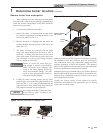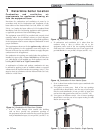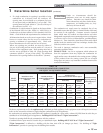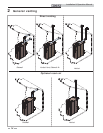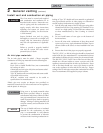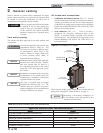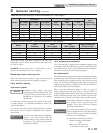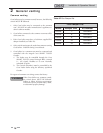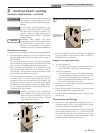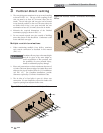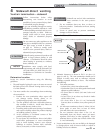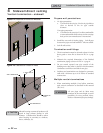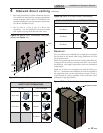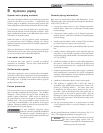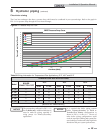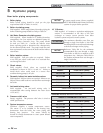
Installation & Operation Manual
19
3 Vertical direct venting
Vent/air termination – vertical
Prepare roof penetrations
1. Air pipe penetration:
a. Cut a hole for the air pipe. Size the air pipe hole as
close as desired to the air pipe outside diameter.
2. Vent pipe penetration:
a. Cut a hole for the vent pipe. For either combustible
or noncombustible construction, size the vent pipe
hole per the vent manufacturer’s instructions.
b. Insert a galvanized metal thimble in the vent pipe
hole (when required by local codes).
3. Space the air and vent holes to provide the minimum
spacing shown in FIG. 3-1.
4. Follow all local codes for isolation of vent pipe when
passing through floors, ceilings, and roofs.
5. Provide flashing and sealing boots sized for the vent pipe
and air pipe.
Termination and fittings
1. Prepare the vent termination coupling and the air
termination elbow (FIG. 3-1) by inserting bird screens.
Bird screens should be obtained locally.
2. The air piping must terminate in a down-turned 180°
return bend as shown in FIG. 3-1. Locate the air inlet
pipe no further than 2 feet (.6 m) from the center of the
vent pipe. This placement avoids recirculation of flue
products into the combustion air stream.
5. Locate terminations so they are not likely to be damaged
by foreign objects, such as stones or balls, or subject to
buildup of leaves or sediment.
ƽ WARNING
12" [305 MM] MINIMUM
ABOVE ROOF /
SNOW LINE
VENT OUTLET
36" [914 MM] MINIMUM
A
BOVE AIR INLET
BIRD SCREEN
[TYPICAL]
Figure 3-2 Vertical Termination of Air and Vent w/Rain
Cap
Follow instructions below when determining
vent location to avoid possibility of severe
personal injury, death or substantial property
damage.
Installation must comply with local
requirements and with the National Fuel
Gas Code, NFPA 54 / ANSI Z223.1 - latest
edition for U.S. installations or CSA B149.1
Installation Code for Canadian installations.
ƽ WARNING
NOTICE
ƽ WARNING
Do not connect any other appliance to the
vent pipe or multiple boilers to a common
vent pipe except as noted in Section 2 on
page 18. Failure to comply could result in
severe personal injury, death, or substantial
property damage.
Determine location
Locate the vent/air terminations using the following guidelines:
1. The total length of piping for vent or air must not exceed
the limits given in the General Venting Section on page 17
of this manual.
2. The vent must terminate at least 3 feet above the highest
place in which the vent penetrates the roof and at least 2 feet
above any part of a building within 10 horizontal feet.
3. The air piping must terminate in a down-turned 180°
return pipe no further than 2 feet (.6 m) from the center of
the vent pipe. This placement avoids recirculation of flue
products into the combustion air stream.
4. The vent piping must terminate in an up-turned coupling
as shown in FIG. 3-1. The top of the coupling or the rain
cap must be at least 36" (914 mm) above the air intake. The
air inlet pipe and vent pipe can be located in any desired
position on the roof, but must always be no further than 2
feet (.6 m) apart and with the vent termination at least 36"
(914 mm) above the air intake.
Rooftop vent and air inlet terminations
must terminate in the same pressure zone,
unless vertical vent sidewall air is set up as
shown in the General Venting - Vertical
Vent, Sidewall Air Section.
BIRD SCREEN
[TYPICAL]
VENT OUTLET
36" MINIMUM
A
BOVE AIR INLET
VENT
COMBUSTION AIR
12" [305 MM] MINIMUM
ABOVE ROOF /
SNOW LINE
Figure 3-1 Vertical Termination of Air and Vent



